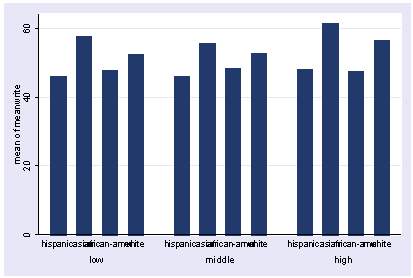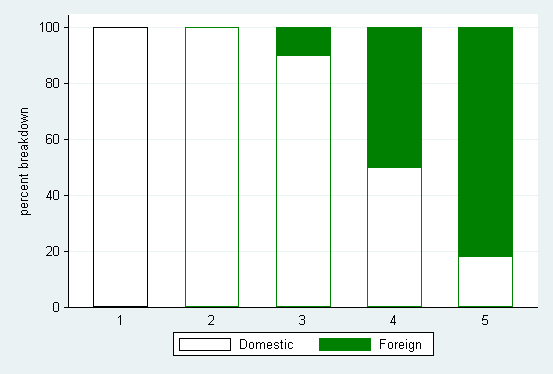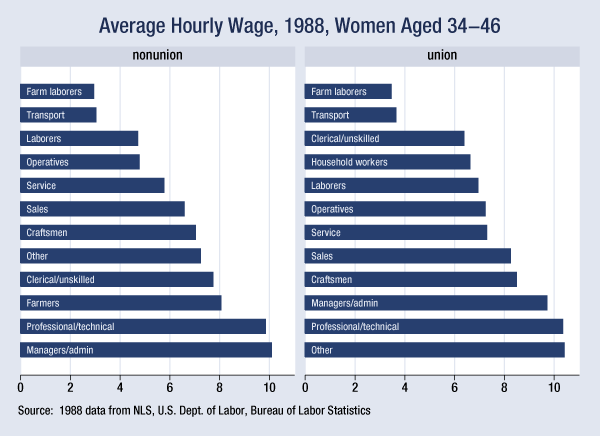
- #GRAPH BAR STATA CODE A VARIABLE#
- #GRAPH BAR STATA HOW TO RECORD CHANGES#
- #GRAPH BAR STATA MANUAL AVAILABLE OVER#



Graph Bar Stata Manual Available Over
Graph Bar Stata Code A Variable
You want a graph with colors that everyone can differentiate. You want a graph that fits the style of your journal. You want a graph that most effectively communicates your message. For more information, see the Stata Graphics Manual available over the web and from within Stata by typing. Stata assumes you are working with continuous data Very simple syntax: hist varname Put a comma after your varname and start adding options bin(): change the number of bars that the graph displays normal: overlay normal curve addlabels: add actual values to bars Histogram optionsTo plot a bar chart with percentages, I used educ <- with(data, table(expenses, education))Education <- round(prop.table(educ,2)*100,digits=0)Xlab='Education level',ylab='Percentages',main="Monthly expenses by education status",beside=T, col = ramp.list,How can I do the same in Stata? There seems to be no easy way to recode a variable like in R with as.factor.
This is the scheme that created the graph at the top. To obtain the set of graphs above, I typedAnd following each of these set scheme commands, I ran the twoway command again.The s2color scheme is the default when you install Stata. The one exception is the transparency in the scatterplot markers and confidence interval area I requested using %8 and %20 within the color() option.Or with the same twoway command, I might get any of the following graphs.What produces these differences? Schemes.By changing the graph scheme, I can easily change the overall look of my graph. To obtain the graph, I typeThis graph mostly uses Stata’s defaults.
The lean2 scheme was created by Svend Juul and is discussed in his Stata Journal article “ Lean mainstream schemes for Stata 8 graphics“. The uncluttered scheme was provided by Gray Kimbrough. For instance, the plottig and plotplain schemes that I used were created by Daniel Bischof and described in his Stata Journal article “ New graphic schemes for Stata: plotplain and plottig“. Many members of Stata’s user community have also contributed schemes. This is where you will find information on using the economist and s1rcolor schemes that I used above.The schemes provided by Stata are only a starting point. Stata provides 11 schemes from which you can choose these schemes are discussed in schemes intro.
Then, look at Vince Wiggins’ talk “ Scheming your way to consistent graphs” from the 2006 UK Stata Users Group meeting. To learn about this, typeIn Stata. If none of these schemes create the style you want, try typing search scheme in Stata to locate and install other schemes.And if none of those schemes are quite what you had in mind, you can write your own scheme.
Graph Bar Stata How To Record Changes
You can also look at our YouTube video that demonstrates how to record changes and play the recording on other graphs.So if you want to change the style of your graphs, try one of Stata’s other schemes, one of the schemes contributed by the community, a scheme you have written yourself, or perhaps a recording from the Graph Editor. Then the next time you draw a graph, sayYou can use graph play to apply the same changes,Or use the play() option when you create the graph.Kevin Crow explains more in his Stata Journal article “ Stata tip 72: Using the Graph Recorder to create a pseudograph scheme“. See the red dot in the menu below? Click on it to start the Graph Recorder, and record the changes as you make them.When you finish, you can give recording a name such as “recording1”. If these are changes that you would like to apply to many other graphs, record them. Then, open the Graph Editor and make your changes. You start by drawing a graph.


 0 kommentar(er)
0 kommentar(er)
